L.E. Carmichael's Blog, page 10
March 10, 2023
Jean Mills: A Yarn About Yarn – And More
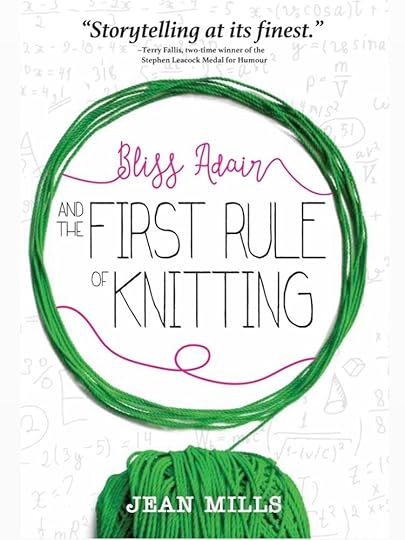 Welcome to Cantastic Authorpalooza, featuring posts by and about great Canadian children’s book creators! Today’s guest:
Jean Mills
. Take it away, Jean!
Welcome to Cantastic Authorpalooza, featuring posts by and about great Canadian children’s book creators! Today’s guest:
Jean Mills
. Take it away, Jean!
I don’t know about other writers, but every story I write has a connection to something in my own life and experience. Music, sports, the Nova Scotia shore and, in Bliss Adair and the First Rule of Knitting – yarn!
My relationship with yarn began in childhood. My mom was a knitter, but she was so busy juggling a full house and a full-time job, she didn’t have much time to indulge. Her sister, my Auntie Jean, certainly did, though. My dolls were well-clothed and there was no shortage of mitts, scarves and hats for my brothers and me.
For Christmas one year, my hockey-playing brother was excited to receive the yarn, pattern, and needles to make himself a blue and white (Maple Leafs, right?) stocking hat. We watched and marvelled. And then, in Girl Guides, I begged my mother to teach me, too, so I could earn a badge for knitting a square. Okay, it was a somewhat geometrically challenged square, but I did get my badge, and I loved the process – and the feel of the yarn, and the needles in my hands.
Over time I progressed to crocheting, and stitch graphs, and Fair Isle and Cowichan sweaters, baby blankets and little animals, and “Nan blankets” – you know, those multicolour granny square throws hanging over the back of the couch. And building a yarn stash because there isn’t a knitter or crocheter anywhere who can walk into a yarn shop without buying something…

Made by mother, using scraps of yarn to crochet granny squares. This is a classic “Nan blanket”.
Yes, I was hooked.
So, no surprise, when the character of Bliss Adair started to take shape in my head – a girl with a gift for math and problem solving – it just seemed right to make her a knitter, too. She runs the Help Desk at her parents’ yarn shop (String Theory – more on this later), which means she helps people fix their mistakes. She leads the Crafting for Community Care club at her school, teaching her peers how to create and give back. But her life is also complicated by the relationships she has with her friends, some of whom are going through life-changing challenges, and who rely on her for support. Sometimes, when she needs to escape for a while, she retreats with yarn and needles, because knitters know that working with yarn and needles or hook is soothing, meditative, and calming. And productive, too.
(An interesting fact: World War I soldiers suffering from post-traumatic stress – known then as “shell shock” – were taught how to knit, to aid them in their recovery. There’s a reason for that.)
Writing Bliss Adair and the First Rule of Knitting also allowed me to call up so many memories from my own yarniac life:
Like the Christmas Eve when I was just finishing a baby blanket for my new great-niece and realized I’d dropped a stitch a few rows back. Panic! Frantic calls to find someone to help me keep the whole thing from unravelling. My knitting-wiz niece, Katie, rode to the rescue and saved the day, just like Bliss and her Help Desk.

It was Christmas Eve and this baby blanket was supposed to be a gift. I was panicking – until my niece Katie took over and fixed my big mistake. Katie saved Christmas!
Or the time I attended a workshop that involved knitting a monkey from a highly complicated pattern, a pattern that nearly defeated me. I call the finished beast, “My Precious”. (Yes, say it just like Gollum does…). The frustrated beginners in the Crafting for Community Care club might be an echo of this experience.

It was supposed to be a fun workshop to knit this little monkey. It was hard work! I call this evil little guy “My Precious”.
And the fun coincidence when a new yarn shop opened up in Fergus, about 15 minutes away from me, while I was well into writing the novel, a shop bearing the same name – String Theory – as the store that Bliss’s parents own. Because string theory and math and yarn kind of go together, don’t they?
Yes, it’s true: I am proud of my overflowing yarn stash, and my crafting basket includes a huge collection of needles and hooks. I have four projects in progress as I write this.
What is The First Rule of Knitting? Sorry! I’m not going to reveal it here. Bliss’s faith in this rule may be tested, but it all works out in the end. And I knew it would – because I was writing from experience.
Jean Mills lives in Guelph, Ontario. Her YA novel, BLISS ADAIR AND THE FIRST RULE OF KNITTING, will be released by Red Deer Press in March 2023, and WINGMAN, her Hi-Lo YA novel in the Orca Soundings series, will be released by Orca Books in April 2023.
March 3, 2023
Wolves for World Wildlife Day
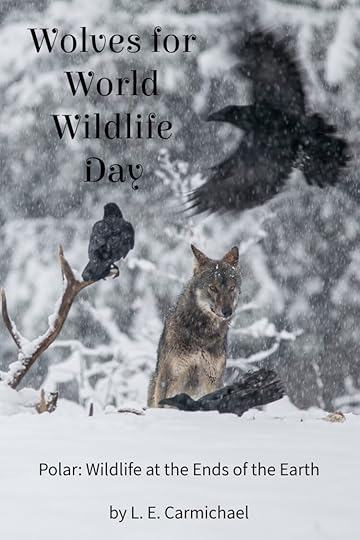 All across the boreal forests of Canada, wolves look for the same things: clean water, safe dens, and places where deer or moose are plentiful. When wolves find everything they need in one area, they establish a territory, and that’s where they stay.
All across the boreal forests of Canada, wolves look for the same things: clean water, safe dens, and places where deer or moose are plentiful. When wolves find everything they need in one area, they establish a territory, and that’s where they stay.
The idea of wolves as territorial has been part of scientific dogma (ha! DOGma!) for so long that, when I submitted my first scientific paper on the genetics of migratory wolves on the Arctic tundra, the journal refused to print it. Indigenous people in the Arctic knew wolves migrated, but scientists had never measured those movements… which meant the scientists reviewing my paper thought I was making it up.
Fortunately, we’ve made some progress since then, and a lot of scientists now recognize that the Traditional Ecological Knowledge of Indigenous peoples around the world is often based on exactly the same kinds of empirical observations used to produce scientific knowledge… meaning it’s just as reliable.
But back to the wolves. What about the Arctic tundra makes wolves migratory?
The Arctic tundra is often called the barren-grounds, because it’s so cold and dry that trees don’t grow. Deer and moose don’t like to live in places without tasty trees, but barren-ground caribou do just fine on the tundra. These caribou form herds that may contain thousands of animals, and females have their babies in traditional areas called calving grounds.
Arctic wolves make their dens as close to the calving grounds as they can. Adult wolves visit the nearby calving grounds, catching caribou and bringing meat back to their pups. But in the autumn, the caribou leave the calving grounds and migrate south to the boreal forest, where there’s more food and shelter in winter. The wolves have to follow, because if they stayed in their denning territories, there’d be nothing left to eat.
As with pretty much everything in science (and in life), there are exceptions! Wolves that stay on the tundra year round have to switch to other kinds of prey: for example, muskoxen, which are bigger, meaner, and harder to bring down than caribou. Wolves will also hunt smaller prey like arctic hares or foxes, but in general, a wolf pack needs large hoofed mammals to survive.
When pickings are slim, wolves receive help from a surprising source – ravens! Ravens that find caribou kick up a fuss, drawing wolves to the prey. Ravens will also lead wolves to carcasses of animals that have died naturally. Raven beaks aren’t strong enough to cut through skin, but wolf teeth are… and the ravens get the leftovers. A relationship like this one, where both species benefit, is called mutualism. Cooperating helps both wolves and ravens survive long arctic winters.
If you’re interested in learning more about the forest, the tundra, or the animals that live there, check out my books The Boreal Forest and Polar: Wildlife at the Ends of the Earth. Happy World Wildlife Day!
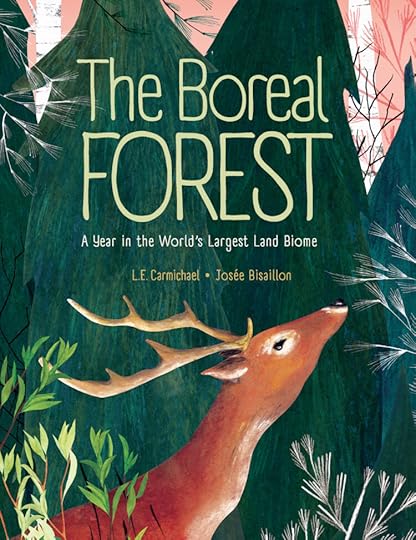
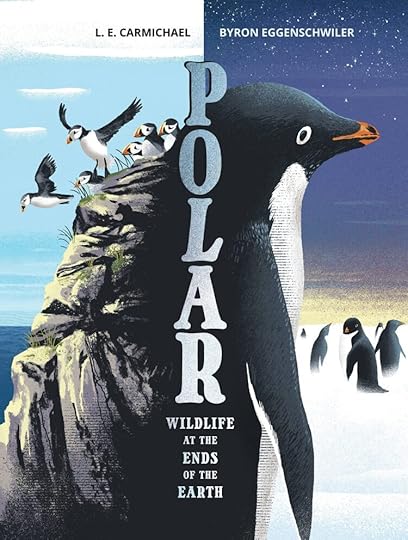
Reminder that I’m booking Polar-themed school visits for May and June – contact me if you’re interested in learning more.
I’m also scheduling a number of book launch events that will be open to the public. Click here for the full schedule – I’d love to see you!
February 27, 2023
23 Cool Facts About Polar Bears
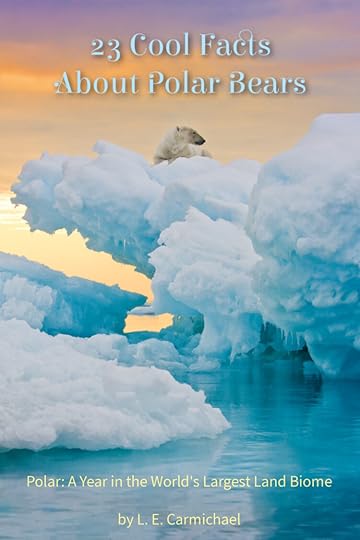 It’s International Polar Bear Day! Since it’s 2023, I’ve rounded up 23 cool facts about these icons of the Arctic, including a surprising discovery I helped make during in my former life as a wildlife geneticist. Is your favourite fact missing from this list? Feel free to add it in the comments!
It’s International Polar Bear Day! Since it’s 2023, I’ve rounded up 23 cool facts about these icons of the Arctic, including a surprising discovery I helped make during in my former life as a wildlife geneticist. Is your favourite fact missing from this list? Feel free to add it in the comments!
1) The polar bear’s closest relatives are brown bears — specifically, the ones living in Siberia.
2) Polar bears are terrestrial (land-based) animals that play a large role in marine (ocean) ecosystems. Marine biologists classify them as fissipeds (split foots) because, unlike true marine mammals with flippers, bears still have separated toes!
3) Polar bears can live up to 32 years.
4) Females weigh up to 700 pounds; males up to 1300.
5) Their paws are up to 30 cm wide, creating natural snowshoes that help spread their body weight over snow and ice.
Habitat6) Polar bears are sometimes found on multi-year ice (sea ice that stays frozen over the summer) but prefer “fresh” ice that forms each winter, because that’s where most of the seals are.
7) In areas where the ice melts in summer, bears move onto land.
8) Wrangel Island (off the northeast coast of Siberia) has the highest density of polar bear dens in the world.
Food9) While denning and raising her cubs, a female polar bear can go up to 8 months without food.
10) Ring seals are polar bears’ favourite food, but they will eat anything they can catch.
11) They don’t catch seals often! One study of polar bears in Svalbard estimated that seal hunts succeed less than 9 percent of the time.
12) Adult walruses are too big for most polar bears to catch. But on Wrangel Island, bears may rush beached walruses to create a stampede. The bears can then eat any animals that were injured in the panic.
13) Arctic foxes often follow polar bears, hoping to scavenge from the bear’s kills. It’s a dangerous strategy, as polar bears sometimes eat the foxes!
14) Polar bears have been found in the stomaches of Greenland sharks! Those sharks had also eaten a lot of species found on the sea floor, suggesting they scavenged on a polar bear carcass, rather than attacking a live bear.
Movement15) In 2006, a Greenpeace expedition spotted a polar bear within one mile of the North Pole! It was over 550 miles from the nearest land.
16) Scientists use radio collars to track the movements of female polar bears. One bear traveled from the Beaufort Sea in Alaska to Northern Greenland. In total, she travel 7162 km over 576 days.
17) Scientists can’t use radio or GPS collars to track male polar bears — their necks are thick and their skulls are narrow, so the collars slip right off!
Surprising Science18) Polar bear fur helps prevent the bear’s body heat from escaping into the cold Arctic air.
19) Polar bear hairs are full of microscopic pockets of air. Their fractal structure not only conserves body heat, it absorbs heat energy from the bear’s environment!
20) When I was a graduate student, bear biologists in Nunavut found a female polar bear whose private parts looked a little bit more like a male bear’s. In all the years they studied her, the bear never gave birth to a cub. I performed DNA testing on a sample of her blood and discovered she had at least part of a Y chromosome in her genome. This genetic anomaly might have been the reason that she was unable to reproduce.
Climate Change and Conservation21) There are between 22,000 and 31,000 polar bears world wide.
22) The International Union for the Conservation of Nature listed polar bears as Vulnerable in 2015. Species listed as Vulnerable could become Threatened or Endangered if we don’t do something to protect them.
23) The greatest threat polar bears face is the loss of Arctic sea ice due to ongoing climate change.
There are lots of things you can do to help protect polar bears, ranging from donating to conservation organizations to reducing your carbon footprint. You can even raise awareness by sharing your favourite polar bear facts on social media – use the official hashtags #InternationalPolarBearDay and #PolarBearDay
Reminder that I’m booking Polar-themed school visits for May and June – contact me if you’re interested in learning more.
I’m also scheduling a number of book launch events that will be open to the public. Click here for the full schedule – I’d love to see you!
February 13, 2023
New Year’s News Nuggets!
 OK, I realize it’s mildly absurd to be writing a Happy New Year post in the middle of February, but here we are, so let’s do this!
OK, I realize it’s mildly absurd to be writing a Happy New Year post in the middle of February, but here we are, so let’s do this!
Did you make any? How are they going for you?
Mine was to make 2023 the year when I finally figure out how to be happy doing less. That doesn’t sound hard, unless – like me – you’ve always used your productivity as a measure of your self-worth. Which is straight-up exhausting and, now that I’m officially middle-aged, seems less and less sustainable over the long term.
Progress wise? It’s not going well. See below.
Manuscript Compete!After 18 months of self-doubt, recriminations, and the most difficult and gruelling research I have ever attempted, I finished the first draft of a new manuscript! Currently scheduled for release in 2025, the contents are still top secret. What I can tell you is that the project has an official GIF, and it is this one:
Madeline Kahn Flames On The Side Of My Face GIFfrom Madeline Kahn GIFs
But I am so proud of the work I’ve done so far, and I can’t wait for all of you to read it! In 2025…
I worked full time on this project during the month of January, which meant ignoring all the other things that kept popping up in my email. Which meant that, when I sent the file off to my editor, I did not REST as per the dictates of my NY’s resolution. I started right in on catch up. Which, in my own defence, attempting to rest with a brim-full to-do list is a non-starter.
The catch up is almost caught up, which means I’m going to have to try “sitting with the discomfort” of not immediately starting something else. “Sitting with discomfort,” as the name might suggest, is pretty uncomfortable, if not downright torturous. But I promised Tech Support, and my therapist, and myself, that I would try. Stay tuned for further updates on that one…
Polar Scores a Star!The first review of Polar: Wildlife at the Ends of the Earth has come in, and Kirkus gave it a star! Here’s the link to the full review, if you’d like to check it out.
Kermit GIF from Kermit GIFsUpcoming Events!
I’m booking Polar-themed school visits for May and June – contact me if you’re interested in learning more.
I’m also scheduling a number of book launch events that will be open to the public. Click here for the full schedule – I’d love to see you!
That’s it for now! I hope 2023 is off to a roaring start for you, too – if you’re so inclined, leave me a comment sharing your own news. I’d love to hear what you’re up to.
December 21, 2022
The Longest Night
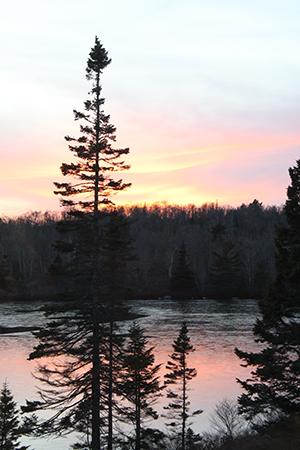 It’s winter solstice here in the northern hemisphere–the longest night of the year. Tomorrow, and each day after, the light returns, one extra moment at a time.
It’s winter solstice here in the northern hemisphere–the longest night of the year. Tomorrow, and each day after, the light returns, one extra moment at a time.
I’ve never been diagnosed with seasonal affective disorder, but my brain and body are deeply sensitive to light. Every fall, as the days get shorter, it gets harder to get out of bed in the morning – my alarm goes off in pitch darkness and my brain growls, “Go back to sleep, it is NIGHT TIME.” I’ve been so tired in the evenings, I’ve been going to bed at 8PM. For me, winter solstice – the astronomical pivot-point between dark and light – is the real New Year’s Eve.
This year, I’m even happier solstice has arrived than usual. Because the last few years have felt like one never-ending longest night, an endless slog through darkness, all-too rarely punctuated by joy. This year, even treasured holiday rituals feel like they’re going to take more spoons than I’ve got to spend.
It’s been a lot, ya’ll. And I’m tired.
If you’re tired, too, here’s my gift to you: permission not to:
join the crowds of holiday shoppers;
bake six kinds of cookies to swap with all your friends;
write an upbeat holiday newsletter when you don’t actually feel upbeat;
flog yourself with aggressively cheerful holiday music and one more Hallmark Christmas Movie.
Instead, give yourself permission:
to say no;
to stay home;
to break from tradition;
to feel what you feel, no matter how messy or “seasonally inappropriate”;
to hibernate while you await the coming of the light.
Be gentle with yourself this year, and we’ll see each other on the other side.
December 2, 2022
Amanda West Lewis – Warming Up
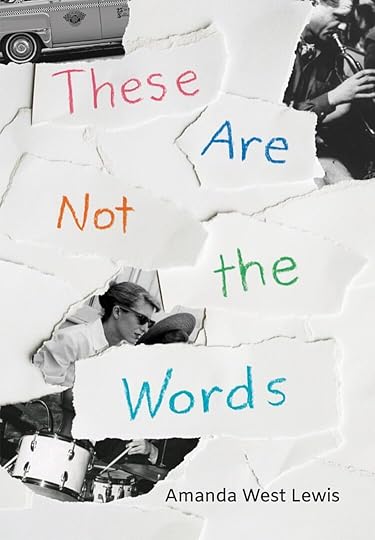 Welcome to Cantastic Authorpalooza, featuring posts by and about great Canadian children’s book creators! Today’s guest:
Amanda West Lewis
. Take it away, Amanda!
Welcome to Cantastic Authorpalooza, featuring posts by and about great Canadian children’s book creators! Today’s guest:
Amanda West Lewis
. Take it away, Amanda!
“In order to be creative you have to know how to prepare to be creative.”
— Twyla Tharp
All artists need to warm up. Painters, actors, dancers, musicians, and writers must all do something to tune up the physical and mental muscles required for the work. As choreographer Twyla Tharp says, when you warm up, won’t hurt yourself. You are safe.
Frankly, I think that everyone who uses their body, heart, and brain to make something needs to warm up. Warming up brings you into your day, into your workspace, into your work. It helps you feel safe to do creatively courageous acts.
I recently gave a talk to a group of Executive Assistants. These folks are incredibly creative and responsive. They need to view things with a global eye, and yet be very detail oriented. They need to be empathetic and intuitive. They need to problem-solve and be incredibly flexible. They have to be brave.
As I thought about it, I realized that they need to approach their jobs in the same way that I approach mine as a writer. So I talked to them about the concept of warming up for their day. I suggested that for them, warming up can involve mindfulness and awareness. Tasting that morning coffee, rather than just inhaling it. Noticing something about a person they are talking to. Listening to the background white noise in the office. We talked about using this mindfulness and intentionality as a creative warm-up for their day.
I took the group through two simple writing prompts suggested by Tharp. One was based on physical awareness in the room (“What do you hear, smell, taste, feel, see?”) and the other was on self-awareness (“What are ten words that describe the essential you?”). What came out of those two simple prompts surprised us all. They discovered new tools and approaches to their work. They reconnected with their essential creativity.
As writers, we use prompts all of the time. Usually, they get us going, help us focus or give us insights into our characters and their backstory. But sometimes warm-up prompts open doors to something larger, something we couldn’t have done without warming up. My novel These Are Not the Words began as such a prompt. It was a warm-up that became a full novel.
I was in a picture book writing workshop. The prompt was to think about your earliest memory. Not a story of something happening, but smells, sounds, tastes, textures, images, feelings that could be dusted off from a pre-literate self. I closed my eyes and pulled myself into the place where Mnemosyne lives. Mnemosyne –– the goddess of memory and the mother of artistic inspiration.
I am crossing the living room late at night. It is dark. The TV is on, but the sound is off. The record player is on, a woman singing soft, low. My bare feet on the floor. Cold. My flannel nightie warm.
The light is on in the kitchen. I want to cross to the kitchen. I’m thirsty.
As I pull at the threads of memory, my adult brain begins to see things.
Pops is in the room, working. I know he is working so I shouldn’t interrupt. A pool of light is spread over the table where he is sitting. Smoke curls from the ashtray. I see only his back.
And suddenly, there is the nugget. My father is there, but somehow not there, not available to me. My four-year-old self knows I must not disturb him. I know that being good means being invisible. I must cross to the kitchen as silently as a ghost.
Mnemosyne had given me a core for a character and a problem. Something that needed to be resolved. Something that my four-year-old child memory could feel, but not comprehend.
I tried to write the scene as a picture book, the language pared down to images and reflected feelings. But there was too much there, too many questions. The moment needed to belong to an older child, an eleven-year-old who could see the strangeness and push against the idea of being invisible. Someone who needed her father to look up from his work.
The scene became the opening of the novel, and importantly, that writing prompt guided the writing style. It’s a novel that uses sense memory, verse, and prose poetry to explore the dissolving relationship between a girl and her father. The fingerprint of the prompt, and of trying to write it as a picture book, is still there.
The prompt warmed me up. I was safe. I could go to unsafe places and stretch.
November 4, 2022
Joan Marie Galat – Too Much Trash: How Litter Is Hurting Animals
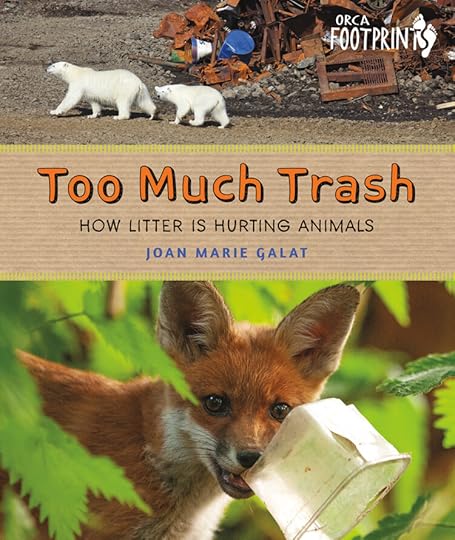 Welcome to Cantastic Authorpalooza, featuring posts by and about great Canadian children’s book creators! Today’s guest:
Joan Marie Galat
. I recommended Joan’s newest book, Mortimer: Rat Race to Space already this week; today, this prolific author is here to discuss a nonfiction title that sounds amazing. Take it away, Joan!
Welcome to Cantastic Authorpalooza, featuring posts by and about great Canadian children’s book creators! Today’s guest:
Joan Marie Galat
. I recommended Joan’s newest book, Mortimer: Rat Race to Space already this week; today, this prolific author is here to discuss a nonfiction title that sounds amazing. Take it away, Joan!
Did you know litter on the ground often ends up in water? It can travel from creeks to rivers, and onward to the sea. When I first dreamed of becoming an author, I didn’t exactly picture myself writing a children’s book about garbage, but the time came when it seemed like the perfect thing to do.
Trash on the ground and in waterways has troubled me for a long time. Like a great many others, I find it upsetting that sea turtles mistake plastic bags for jellyfish, dogs injure their paws on littered shards of glass, and cows die from licking automotive batteries left in farm fields. I grit my teeth when gulls outside fast-food restaurants stalk me for fries, or squirrels wait for me to leave my picnic table.
Species that seek litter and consume human foods don’t get the natural nutrients they need to thrive. Consuming indigestible objects—like plastics—can make their stomachs feel so full, they stop eating and die of starvation.
In a problem close to littering, people sometimes toss ducks and other waterfowl bread or popcorn, feeling they are helping. Like littering, however, feeding wildlife is harmful. (National Geographic offers a quick summary on why feeding ducks is a problem.) Animals that grow accustomed to receiving food or ingesting litter, like sea lions and deer, can become aggressive toward people. They may also harm one another when competing for handouts or garbage.
Despite my strong feelings on litter, the idea to write a book on how it impacts animals and their habitats needed to percolate. It was essential for me to figure out the best way to raise the topic for my target audience—children ages 8-12. How could I present the troubling things happening to animals in ways that would not make readers want to close the book?
In the end, I overcame the challenge using the same approach as the problem-solvers I researched—take this giant issue and make it smaller. Too Much Trash—How Litter is Hurting Animals is broken into sections that profile wildlife, pets/farm animals, and ocean species. I examine the scope of the problem, how it can be fixed, and the unique and creative solutions people are finding to protect animals and habitats from harmful litter. The book delivers the promising messages that solutions exist and everyone can make a difference.
Too Much Trash is part of the Orca Footprints nonfiction series for middle-grade readers. With photographs throughout, it examines how garbage hurts animals and their habitats, and answers questions about an important environmental issue. It is scheduled for release May 16, 2023, and pre-orders are now available through Orca Book Publishers, Amazon, and other bookstores. Where possible, please support your local independent bookseller.
Find a Canadian indie.Find a USA independent bookstoreJoan Marie Galat is the author of more than 25 books in eight languages. Published by National Geographic Kids, Scholastic, DCB, and others, she explores science themes relating to ecology, astronomy, space, engineering, and other topics. Too Much Trash is her first Orca title. Joan offers in-person and virtual presentations and workshops, as well as corporate training. She writes from just outside Edmonton in an office shared with two noisy budgies.
November 1, 2022
This I Read Canadian Day, Blast Off with Mortimer: Rat Race to Space
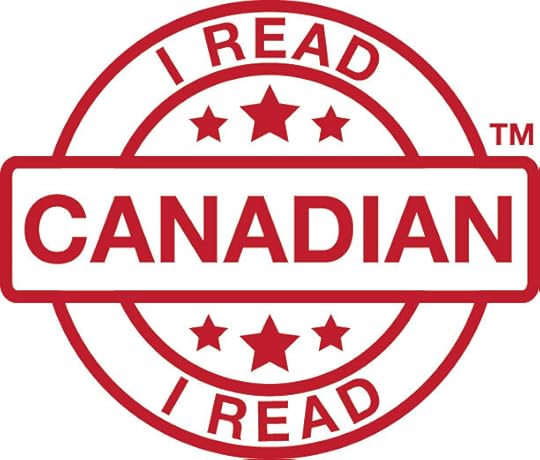 Tomorrow is I Read Canadian Day, the day we support Canada’s fabulous children’s bookmakers by reading a Canadian book for 15 minutes.
Tomorrow is I Read Canadian Day, the day we support Canada’s fabulous children’s bookmakers by reading a Canadian book for 15 minutes.
Don’t be surprised if you find yourself wanting to read for more than 15 minutes – in fact, we encourage it! And if you want to read books by Canadian authors and illustrators every day of the year, well. Not only will you never run out of fabulous stories to explore, but we will love you more than we already do.
After all, readers are the reason that authors and illustrators get to do what we do: tell stories. Without you, we’d have to be nurses or lawyers or carpenters or truck drivers or teachers or any one of a number of other people whose jobs require them to put on their “leaving the house pants” to go to work. And believe me, pyjama pants are one of the major perks of this job. 
This year, I Read Canadian day is happening on November 22. Visit the event’s official website for all the details. There are tons of free resources, including two free, live-streamed author events that are happening on the day!
What Should I Read?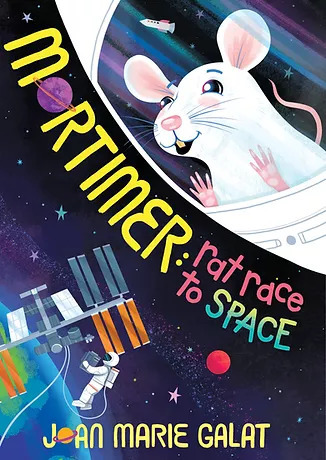 One of my books, if you like! Or if you’re in the mood for a novel, might I suggest Mortimer: Rat Race to Space, by my friend and space expert, Joan Marie Galat?
One of my books, if you like! Or if you’re in the mood for a novel, might I suggest Mortimer: Rat Race to Space, by my friend and space expert, Joan Marie Galat?
Best for readers ages 8-12, the novel is about Mortimer T. Flightdeck, a lab rat with one goal: to prove that rats, not humans, should be the first species to colonize Mars. He’s got a point. After all, rats need less space and less food than humans. They don’t wear underpants, and they don’t waste precious water on stuff like showers. That’s good news in space, where deliveries of supplies from Earth can cost billions of dollars.
On the other hand, rats aren’t so great a planning ahead, as Mortimer discovers when his impulsive decisions get him into trouble with humans, hungry owls, and other rats in the lab. And while rats love to chew wires, humans are better at hooking them together to create working life support systems. At least, most of the time. As Mortimer discovers when he stows away on a spacewalk outside the International Space Station, space travel works best when astronauts – be they rat OR human – work as a team.
There are several things I loved about Mortimer: Rat Race to Space. First, the eye-popping facts that Joan manages to weave seamlessly into the story. Kids who are following Mortimer’s escapades will learn about space – and rats! – without even noticing. Second, the point of view. Normally when author’s say “point of view,” we mean the character who’s telling the story. And while Mortimer is a charming narrator, I’m using “point of view” to mean “rat’s eye view of the world.” You can really tell that Joan took the time to think about how rats experience the human world. Mortimer gives people nicknames based on their shoes (at eye-level to a rat!) or how their hands feel when they touch him, and he describes his surroundings using this physical perspective and a rat’s frame of reference. For example, one human has a freckle shaped just like a rat’s food pellet! These little details helped Mortimer characters feel authentic and fully-formed.
Also, it’s a fun, fast-paced adventure, perfect for kids who love animals or outer space.
Happy I Read Canadian Day! What will YOU be reading?
October 21, 2022
Judy Ann Sadler: Inspiration All Around
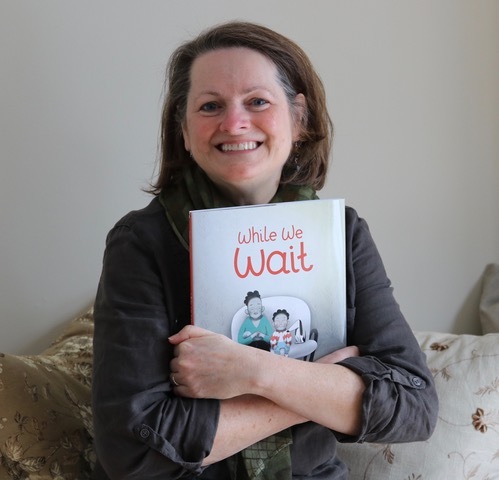 Welcome to Cantastic Authorpalooza, featuring posts by and about great Canadian children’s book creators! Today’s guest:
Judy Ann Sadler
. Take it away, Judy Ann!
Welcome to Cantastic Authorpalooza, featuring posts by and about great Canadian children’s book creators! Today’s guest:
Judy Ann Sadler
. Take it away, Judy Ann!
I live in a village that remained mostly unchanged for a few decades. We were surrounded by corn fields and horse pastures and that suited us just fine. But then the nearby big city annexed neighbouring towns including ours and that’s when things started to change. Farms were bulldozed and divided, pastures were dug up and drained, and new roads were carved into meadows. And once the roads were in place, then the building boom began!
All this disruption upset me. I hated to see the loss of farm land, but I also knew that growth and change are inevitable. I was going to have to change my attitude. Instead of wishing all the heavy equipment away, I started watching the huge vehicles with my grandkids. They couldn’t get enough of the snorts and clangs and beeps! They marvelled at the dump trucks, cement mixers, excavators, bulldozers and every other type of digger. We watched as dirt was piled sky high and rocks of all sizes were picked up and tossed aside. Somehow, I acquired the digger bug and got excited about diggers, too!
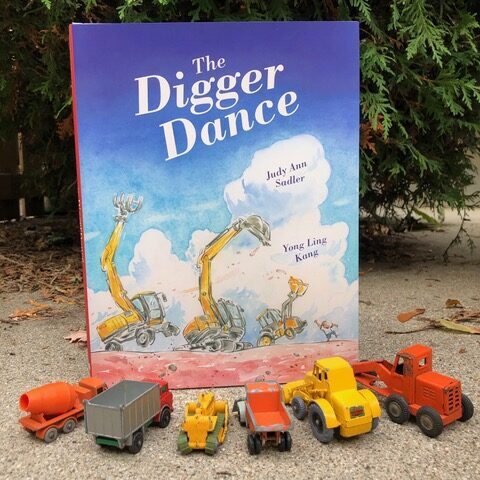 One afternoon while I was out walking, I noticed three excavators far across a field. I was amazed to see them working in perfect harmony. It looked quite beautiful! The digger in the centre lifted straight up while one on each side lifted and swivelled, each turning in the opposite direction. All I could think was, the diggers are dancing! A story was born. I gathered books on all types of heavy equipment and then brainstormed dance moves. It wasn’t too difficult to make the comparison work smoothly. But of course every story has many elements, and I knew mine needed a few more. In another recent book that I wrote, While We Wait, (Illustrated by Élodie Duhameau, Owlkids Books, 2022) the main character had to somehow get through an extremely long day. I thought it might be fun to make this new-book character have to wait for a chance to watch heavy equipment in action, so I added a rainy day to delay the fun. And what to do while it rained? Why not bake? It turns out, baking is a lot like a construction site with all the loading, smoothing, and rolling going on! Really, I had way too much fun with The Digger Dance (illustrated by Yong Ling Kang, Owlkids Books, 2022). I’m so often asked, where do you get your ideas? The answer is usually that a story is inspired by an ordinary incident. Like watching diggers at a construction site. Or, in the case of While We Wait, sitting with my mom at an appointment, both of us sitting and knitting and waiting. There is inspiration all around us everyday.
One afternoon while I was out walking, I noticed three excavators far across a field. I was amazed to see them working in perfect harmony. It looked quite beautiful! The digger in the centre lifted straight up while one on each side lifted and swivelled, each turning in the opposite direction. All I could think was, the diggers are dancing! A story was born. I gathered books on all types of heavy equipment and then brainstormed dance moves. It wasn’t too difficult to make the comparison work smoothly. But of course every story has many elements, and I knew mine needed a few more. In another recent book that I wrote, While We Wait, (Illustrated by Élodie Duhameau, Owlkids Books, 2022) the main character had to somehow get through an extremely long day. I thought it might be fun to make this new-book character have to wait for a chance to watch heavy equipment in action, so I added a rainy day to delay the fun. And what to do while it rained? Why not bake? It turns out, baking is a lot like a construction site with all the loading, smoothing, and rolling going on! Really, I had way too much fun with The Digger Dance (illustrated by Yong Ling Kang, Owlkids Books, 2022). I’m so often asked, where do you get your ideas? The answer is usually that a story is inspired by an ordinary incident. Like watching diggers at a construction site. Or, in the case of While We Wait, sitting with my mom at an appointment, both of us sitting and knitting and waiting. There is inspiration all around us everyday.
For more on Judy Ann and her books, visit her website or follow her on Instagram.
October 7, 2022
Karen Krossing: Sparking Connections With One Tiny Bubble
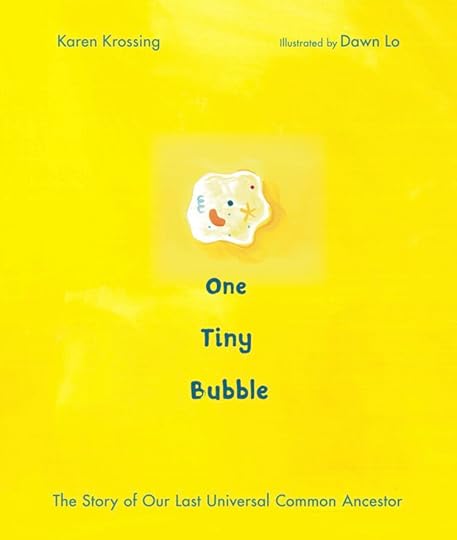 Welcome to Cantastic Authorpalooza, featuring posts by and about great Canadian children’s book creators! Today’s guest:
Karen Krossing
. Take it away, Karen!
Welcome to Cantastic Authorpalooza, featuring posts by and about great Canadian children’s book creators! Today’s guest:
Karen Krossing
. Take it away, Karen!
I’m not a scientist. I’m a science lover. I have been one since childhood.
Back then, a special book on my shelf was a science textbook that my father co-wrote. I couldn’t understand the big words or concepts then, but I still flipped through the pages in wonder.
In elementary school, I entered the science fair every year, winning a ribbon sometimes. I loved thinking up ideas for experiments. One time, I studied mold on various foods after I found a moldy orange in my family’s fridge. Another time, I experimented with substances that dissolved in water, and those that didn’t. I loved asking questions, forming hypotheses, creating experiments, and marvelling at the results.
When I was first considering career options, both writing and science were on my radar. Although I chose to become a writer, I also added a technical writing program to my writing education, and I’ve written and edited various technical, science, and social-science materials over the years, as well as writing fiction for kids and teens.
Now, I follow new scientific developments. I adore science magazines and documentaries. One documentary sparked an idea for a nonfiction picture book. It mentioned our Last Universal Common Ancestor, or LUCA, and I was fascinated by the story of this single cell that formed under harsh conditions over 3.5 billion years ago—the cell that all life currently on Earth evolved from. I wanted to write this feel-good story of the origin of our Earth family, but I wondered if I was the right person to do it. Wouldn’t it be better if I was a scientific expert in the field?
Full of doubt and excitement, I began to research. I consulted LUCA experts. And gradually, I began to see my role as a translator of high-level scientific concepts into child-centred language and experiences. Also, I could use my fiction-writing skills to craft this true story of LUCA, helping the child reader connect to it. Perhaps, I was well-suited to write this book.
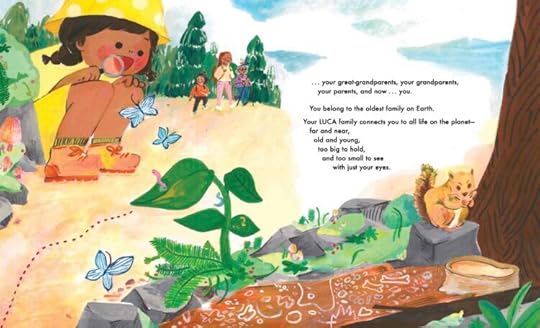 According to LUCA expert Dr. William Martin of the Institute of Molecular Evolution in Düsseldorf, One Tiny Bubble: The Story of Our Last Universal Common Ancestor “explains how living things fit into the big picture of Earth’s history. It takes children on an exciting journey from life’s emergence on a young, rocky Earth, through plants and dinosaurs, all the way to our grandmas and grandpas and us.”
According to LUCA expert Dr. William Martin of the Institute of Molecular Evolution in Düsseldorf, One Tiny Bubble: The Story of Our Last Universal Common Ancestor “explains how living things fit into the big picture of Earth’s history. It takes children on an exciting journey from life’s emergence on a young, rocky Earth, through plants and dinosaurs, all the way to our grandmas and grandpas and us.”
To connect young readers with this exciting journey, I borrowed from traditional story structure to outline the manuscript, and I thought of LUCA as my protagonist. I chose poetic, accessible, and vibrant language. I used a direct address to the reader, helping them to connect to LUCA as the first member of their family. I selected imagery that linked to a child’s world, for example, by showing the size of LUCA as “tinier than a cupcake sprinkle.” Finally, I used the theme of connection to strengthen the narrative story, and I established a mood of wonder about evolution and the celebration of family.
Lucky for me, Owlkids Books saw the potential in my manuscript, and they found the ideal illustrator to bring LUCA to life. Dawn Lo’s engaging illustrations add an explosion of colour, whimsy, and fun to the book. I’m also grateful to Dr. Martin for lending his expertise to this project as a consultant and reviewer. In One Tiny Bubble, we’ve created a book that I would have adored as a young science lover, and I hope it inspires children and parents to love LUCA—and science—as much as I do.
For ideas about how to share this book with young readers, please see our Discussion Guide and Colouring Pages.
To learn more about Karen Krossing and her books, please visit her website or follow her on Twitter.



